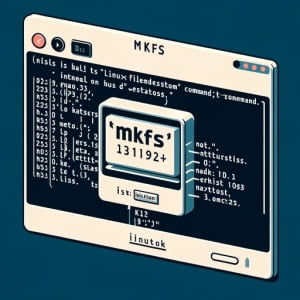How to Install and Use the Linux ‘mkfs’ Command

Are you looking to format a disk partition in Linux but unsure how to proceed? For many Linux users, especially beginners, the process might seem a bit daunting. However, the ‘mkfs’ command is a robust tool that rovides a reliable method for formatting disk partitions in your Linux system. It’s readily available on most package management systems, making the installation process straightforward once you understand the steps.
In this guide, we will walk you through the process of installing and using the ‘mkfs’ command in Linux. We will provide instructions for both APT-based distributions like Debian and Ubuntu, and YUM-based distributions like CentOS and AlmaLinux. We will also delve into more advanced topics, such as compiling the ‘mkfs’ command from source and installing a specific version. Finally, we will guide you on how to use the ‘mkfs’ command and verify that the correct version is installed.
So, let’s dive in and start installing the ‘mkfs’ command on your Linux system!
TL;DR: How Do I Install and Use the ‘mkfs’ Command in Linux?
The
'mkfs'command is typically pre-installed in most Linux distributions, you can verify this with the command,mkfs --version. However if you are receiving messages like, ‘mkfs: command not found’, you may need to add it with,sudo apt-get install dosfstoolsorsudo yum install util-linux.
You can use it to format a disk partition by running the command below:
sudo mkfs -t [type] [device]
In this command, replace ‘[type]’ with the type of file system you want to use (like ext4, xfs, etc.), and ‘[device]’ with the disk partition (like /dev/sda1, /dev/sdb1, etc.).
For instance, to format a partition (/dev/sdb1) with the ext4 file system, you would run:
sudo mkfs -t ext4 /dev/sdb1
This is a basic way to use the ‘mkfs’ command in Linux, but there’s much more to learn about installing and using ‘mkfs’. Continue reading for more detailed information and advanced usage scenarios.
Table of Contents
- Understanding the ‘mkfs’ Command
- Installing ‘mkfs’ from Source Code
- Installing Different Versions of ‘mkfs’
- Verifying the Installation and Basic Usage of ‘mkfs’
- Exploring Alternative Methods for Disk Formatting in Linux
- Troubleshooting Common ‘mkfs’ Issues
- Understanding Linux File Systems
- The Role of Disk Partitioning in Linux
- The Importance of Disk Management in System Administration
- The Significance of Disk Partitioning and File System Types
- Wrapping Up: Installing the ‘mkfs’ Command in Linux
Understanding the ‘mkfs’ Command
The ‘mkfs’ command is a crucial tool in Linux for managing file systems. It’s primarily used for formatting or creating a new file system, which is essentially the structure in which data is stored on a disk. This is particularly useful when you’ve added a new disk to your system, or you want to change the file system of an existing disk.
Installing ‘mkfs’ with APT
If you’re using an APT-based distribution like Ubuntu or Debian, the ‘mkfs’ command is usually pre-installed. You can check its presence by typing the following command:
mkfs
If it’s not installed, you will see a message like ‘mkfs: command not found’. In that case, you can install it using the APT package manager with the following command:
sudo apt-get install dosfstools
After the installation is complete, you can verify the installation by typing ‘mkfs’ again. This time, you should see a list of available ‘mkfs’ utilities.
Installing ‘mkfs’ with YUM
For YUM-based distributions like CentOS or AlmaLinux, the ‘mkfs’ command comes pre-installed as part of the ‘util-linux’ package. You can verify its presence by typing ‘mkfs’. If it’s not installed, you can install it using the following command:
sudo yum install util-linux
After the installation, you can verify the installation by typing ‘mkfs’ again. This time, you should see a list of available ‘mkfs’ utilities.
Formatting a Disk Partition with ‘mkfs’
Once the ‘mkfs’ command is installed, you can use it to format a disk partition. Let’s say you have a partition ‘/dev/sdb1’ that you want to format with the ‘ext4’ file system. You can do this by running the following command:
sudo mkfs -t ext4 /dev/sdb1
# Output:
mke2fs 1.44.1 (24-Mar-2018)
Creating filesystem with 26104 1k blocks and 65536 inodes
Filesystem UUID: 5f7e5c3e-8f4e-4f04-88cb-5f463a5c6e8c
Superblock backups stored on blocks:
8193, 24577
Allocating group tables: done
Writing inode tables: done
Creating journal (1024 blocks): done
Writing superblocks and filesystem accounting information: done
In the output, you can see that the ‘mkfs’ command has created an ‘ext4’ file system on the ‘/dev/sdb1’ partition. This means you’ve successfully formatted the partition with the ‘ext4’ file system.
Installing ‘mkfs’ from Source Code
If you want to install the ‘mkfs’ command from its source code, you can do so by following these steps. First, download the source code from the official website. Then, extract the downloaded file and navigate to the extracted directory. Finally, compile and install the software using the ‘make’ and ‘make install’ commands.
wget [URL to the source code]
tar -xvf [downloaded file]
cd [extracted directory]
make
sudo make install
This will compile and install the ‘mkfs’ command from the source code.
Installing Different Versions of ‘mkfs’
From Source Code
To install a specific version of ‘mkfs’ from source code, you need to download the source code for that specific version. The process is similar to installing the command from source code, as described above. The only difference is that you need to specify the URL for the specific version you want to install.
Using Package Managers
APT
In APT-based distributions, you can specify the version of a package during installation by appending ‘=version’ to the package name. For example:
sudo apt-get install dosfstools=version
YUM
In YUM-based distributions, you can install a specific version of a package by specifying the version number during installation. For example:
sudo yum install util-linux-version
Version Comparison
Different versions of ‘mkfs’ may have different features, bug fixes, or compatibilities. Here’s a brief comparison of a few versions:
| Version | Key Changes/Features | Compatibility |
|---|---|---|
| Version 1 | Initial release | Linux 2.6 or later |
| Version 2 | Added support for ext4 | Linux 2.6.28 or later |
| Version 3 | Added support for exFAT | Linux 3.8 or later |
Verifying the Installation and Basic Usage of ‘mkfs’
Verifying the Installation
You can verify that the ‘mkfs’ command has been installed correctly by running the following command:
mkfs --version
This command will display the version of ‘mkfs’ that is currently installed on your system.
Basic Usage of ‘mkfs’
You can format a disk partition with a specific file system using ‘mkfs’. For example, to format a partition with the xfs file system, you can run the following command:
sudo mkfs -t xfs /dev/sdb1
In this command, ‘-t xfs’ specifies the file system type, and ‘/dev/sdb1’ is the disk partition to format. After running this command, the ‘/dev/sdb1’ partition will be formatted with the xfs file system.
Exploring Alternative Methods for Disk Formatting in Linux
While ‘mkfs’ is a versatile and widely-used tool for managing file systems in Linux, it’s not the only option. There are alternative methods for formatting disk partitions in Linux that can offer different features or capabilities. One such alternative is the ‘parted’ command.
Using ‘parted’ for Disk Formatting
‘Parted’ is a powerful command-line utility designed to handle disk partitions. It supports multiple file systems and allows you to create, resize, and delete disk partitions.
To format a partition with ‘parted’, you first need to create a partition and then make a file system on it. Here’s how you can do it:
sudo parted /dev/sdb
mkpart primary ext4 1MiB 100%
quit
sudo mkfs.ext4 /dev/sdb1
In this example, we’re using ‘parted’ to create a new partition on the ‘/dev/sdb’ disk. The ‘mkpart’ command creates a new partition, ‘primary’ specifies the partition type, ‘ext4’ is the file system type, and ‘1MiB 100%’ sets the start and end of the partition. After creating the partition, we use ‘mkfs.ext4’ to format the new partition.
Pros and Cons of ‘parted’ vs ‘mkfs’
While both ‘mkfs’ and ‘parted’ can format disk partitions, they each have their strengths and weaknesses.
Advantages of ‘mkfs’:
- Easy to use and understand, especially for beginners.
- Supports multiple file systems.
Disadvantages of ‘mkfs’:
- Doesn’t support partition management (like creating, deleting, or resizing partitions).
Advantages of ‘parted’:
- Supports partition management in addition to formatting.
- Supports more file systems than ‘mkfs’.
Disadvantages of ‘parted’:
- More complex to use, especially for beginners.
Recommendations
If you’re a beginner or if you only need to format disk partitions, ‘mkfs’ should be sufficient for your needs. However, if you need more advanced features like partition management, ‘parted’ might be a better choice.
Troubleshooting Common ‘mkfs’ Issues
Like any tool, you may encounter some issues when using the ‘mkfs’ command. Here are a few common problems and their solutions.
Issue: ‘mkfs’ Command Not Found
If you receive a message saying ‘mkfs: command not found’, it means that the ‘mkfs’ command is not installed in your system.
mkfs
# Output:
mkfs: command not found
To solve this, you can install ‘mkfs’ using your package manager, like APT or YUM. For example, in APT-based distributions, you can install ‘mkfs’ using the following command:
sudo apt-get install dosfstools
Issue: Can’t Format Mounted Partition
If you try to format a mounted partition, ‘mkfs’ will display an error message. This is a safety feature to prevent data loss.
sudo mkfs -t ext4 /dev/sda1
# Output:
/dev/sda1 is mounted; will not make a filesystem here!
To solve this, you need to unmount the partition before formatting it. You can do this with the ‘umount’ command:
sudo umount /dev/sda1
sudo mkfs -t ext4 /dev/sda1
Issue: Incorrect File System Type
If you specify an incorrect file system type, ‘mkfs’ will display an error message. For example, if you try to use ‘mkfs’ with a non-existent file system type like ‘abc’, you will see the following error:
sudo mkfs -t abc /dev/sda1
# Output:
mkfs.abc: No such file or directory
To solve this, make sure to specify a valid file system type. Common file system types include ‘ext4’, ‘xfs’, and ‘ntfs’.
Considerations When Using ‘mkfs’
When using the ‘mkfs’ command, there are a few things to keep in mind:
- Always double-check the partition you’re formatting. ‘mkfs’ will delete all data on the partition, so make sure you’re formatting the correct one.
- Be aware that different file systems have different features and compatibilities. Choose the one that best suits your needs.
- Remember that some file systems, like NTFS, may require additional packages to be installed. For example, to use ‘mkfs’ with the NTFS file system, you need to install the ‘ntfs-3g’ package.
Understanding Linux File Systems
The Linux operating system uses a variety of file systems, each designed for specific use cases and offering unique features. Some of the commonly used file systems in Linux include ext4, XFS, Btrfs, and NTFS.
What is a File System?
A file system is a method of storing and organizing data on a storage device like a hard disk or SSD. It determines how data is stored and retrieved, and it’s crucial for the performance, reliability, and features of your system.
lsblk -f
# Output:
NAME FSTYPE LABEL UUID MOUNTPOINT
sda
sda1 ext4 5f7e5c3e-8f4e-4f04-88cb-5f463a5c6e8c /
sdb
sdb1 xfs 6a8e5c3f-9f4d-4f03-88db-5f463a5c6e8d /mnt
In this example, the ‘lsblk -f’ command lists all block devices (like hard disks and SSDs) along with their file system types. You can see that ‘/dev/sda1’ uses the ext4 file system and ‘/dev/sdb1’ uses the XFS file system.
Importance of Choosing the Right File System
Different file systems offer different features. For example, ext4 is widely used due to its robustness and excellent performance, while XFS offers high scalability and was specifically designed to handle large amounts of data. Btrfs, on the other hand, offers advanced features like snapshotting and copy-on-write.
Choosing the right file system depends on your specific needs. If you’re running a standard desktop system, ext4 is a reliable choice. However, if you’re dealing with large amounts of data, XFS or Btrfs might be more suitable.
The Role of Disk Partitioning in Linux
Disk partitioning is the practice of dividing a disk’s storage space into separate sections, each of which acts as a separate disk. This allows you to organize your data better and can improve your system’s performance and reliability.
In Linux, you can manage disk partitions using various tools, including ‘fdisk’, ‘parted’, and ‘gparted’. These tools allow you to create, delete, resize, and manage partitions on your disk.
sudo fdisk -l
# Output:
Disk /dev/sda: 30 GiB, 32212254720 bytes, 62914560 sectors
Units: sectors of 1 * 512 = 512 bytes
Sector size (logical/physical): 512 bytes / 512 bytes
I/O size (minimum/optimal): 512 bytes / 512 bytes
Disklabel type: dos
Disk identifier: 0x5f7e5c3e
Device Boot Start End Sectors Size Id Type
/dev/sda1 * 2048 62914559 62912512 30G 83 Linux
In this example, the ‘fdisk -l’ command lists all disk partitions. You can see that the ‘/dev/sda’ disk has one partition (‘/dev/sda1’), which uses the entire disk space.
When you format a disk partition using the ‘mkfs’ command, you’re essentially creating a file system on that partition. This allows you to store and organize data on that partition in a way that’s determined by the file system.
The Importance of Disk Management in System Administration
In the realm of system administration, disk management plays a pivotal role. It’s not just about creating and deleting partitions or formatting a disk. It’s about understanding how data is stored, accessed, and managed on a storage device. The choice of file system, the size of partitions, and the layout of data can significantly impact system performance and reliability.
For instance, a system administrator might choose to use different file systems for different partitions based on their specific needs. They might use ext4 for the root partition due to its robustness and stability, XFS for a partition that will store large files due to its excellent large file handling, and NTFS for a partition that needs to be accessed by Windows systems.
lsblk -f
# Output:
NAME FSTYPE LABEL UUID MOUNTPOINT
sda
sda1 ext4 5f7e5c3e-8f4e-4f04-88cb-5f463a5c6e8c /
sdb
sdb1 xfs 6a8e5c3f-9f4d-4f03-88db-5f463a5c6e8d /mnt
sdc
sdc1 ntfs 7b8e5c3d-9e4c-4f02-88da-5f463a5c6e8e /win
In this example, the system administrator has used ext4 for the root partition (‘/dev/sda1’), XFS for a data partition (‘/dev/sdb1’), and NTFS for a partition that needs to be accessed by Windows systems (‘/dev/sdc1’).
The Significance of Disk Partitioning and File System Types
Disk partitioning and file system types are two fundamental concepts in disk management. Disk partitioning allows you to divide a disk into separate sections, each of which can be managed independently. This can improve performance, make backups easier, and provide flexibility in terms of file system choice.
File system types, on the other hand, determine how data is stored and organized on a partition. Different file systems offer different features and capabilities, and choosing the right one can have a significant impact on your system’s performance and reliability.
Further Resources for Disk Management Mastery
If you wish to delve deeper into the world of disk management in Linux, here are a few resources that you might find useful:
- The Linux System Administrator’s Guide: An overview of system administration in Linux, including a section on disk management.
The Linux Documentation Project: A wealth of resources on various Linux topics, including file systems and disk partitioning.
GNU Parted Manual: The official manual for the ‘parted’ command, a powerful tool for managing disk partitions in Linux.
Wrapping Up: Installing the ‘mkfs’ Command in Linux
This guide has provided a comprehensive exploration of the ‘mkfs’ command in Linux, a powerful tool for formatting disk partitions and managing file systems. Whether you’re a beginner or an experienced user, understanding and effectively using ‘mkfs’ is a crucial skill in Linux system administration.
We began with the basics, learning how to install and use the ‘mkfs’ command to format a disk partition. We then delved into more advanced topics, such as installing ‘mkfs’ from source code, installing different versions, and verifying the installation. We also discussed the use of the ‘parted’ command as an alternative method for formatting disk partitions.
Along the way, we tackled common issues you might encounter when using ‘mkfs’, such as the ‘command not found’ error, issues with formatting mounted partitions, and specifying incorrect file system types. For each problem, we provided practical solutions and code examples to help you troubleshoot effectively.
| Method | Pros | Cons |
|---|---|---|
| ‘mkfs’ | Easy to use, supports multiple file systems | Doesn’t support partition management |
| ‘parted’ | Supports partition management and more file systems | More complex to use |
Whether you’re just starting out with ‘mkfs’, looking to level up your disk management skills, or exploring alternative methods, we hope this guide has given you a deeper understanding of ‘mkfs’ and its capabilities.
With its versatility and wide support for various file systems, ‘mkfs’ is a powerful tool for disk management in Linux. Now, you’re well equipped to handle disk formatting tasks with ease. Happy coding!


